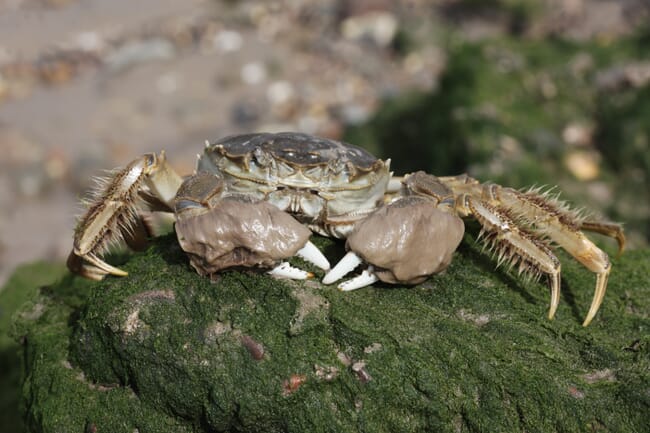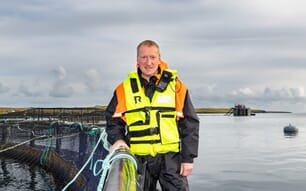
The Chinese mitten crab (Eriocheir sinensis) – named for its unusual furry claws – is a bottom-dwelling omnivore that eats or outcompetes other species and digs destructive burrows in riverbeds and dikes. © Shutterstock
Although the crabs contain dioxins, PCBs, and other contaminants, they are generally safe to eat in moderation, concludes a report published in the Environmental Science and Technology.
The crabs are a popular dish in Asian restaurants, and researchers studying them have proposed that commercial harvesting might help keep their numbers down, writes Erika Engelhaupt. But first, the team of scientists, which includes researchers from London’s Natural History Museum as well as UK food and health agencies, needed to determine whether crabs living in contaminated environments are safe to eat.
The crabs hail originally from coastal China and other parts of Southeast Asia, and they have become established across Europe. In the UK today, “there is evidence that the Chinese population imports or catches them locally,” says zoologist and study co-author Philip Rainbow of the Natural History Museum.
The Chinese mitten crab (Eriocheir sinensis) – named for its unusual furry claws – is a bottom-dwelling omnivore that eats or outcompetes other species and digs destructive burrows in riverbeds and dikes. Contaminants such as heavy metals and PCBs are of particular concern in the crabs, because many live in contaminated urban watersheds and because pollutants accumulate in their fatty brown meat, which includes the hepatopancreas and gonads and is a highly prized delicacy. Crabs are harvested in the fall when their gonads are large and ripe, as they return to estuaries in huge numbers to mate.
The researchers measured contaminant levels in crabs from the Thames River estuary and from the Lek and Rhine rivers in The Netherlands, where fishers are harvesting mitten crabs for sale to restaurants. Levels of toxic metals, dioxins, organochlorines, and PCBs were mostly below European regulatory limits for food, although levels of lead and benzo[a]pyrene (a carcinogenic PAH) in brown meat occasionally exceeded limits. This is notable, Rainbow says, because brown meat is excluded from current EU regulations, as it is not eaten nearly as often as white meat in crabs. “It just happens that the way the Chinese eat these crabs, it’s the brown meat that’s attractive,” he says.
The researchers suggest that men, or women past their reproductive years, could safely eat several portions of Thames crabs per week while they are in season but should not eat as many Dutch crabs, which have higher contaminant levels. Women of childbearing age and children should eat fewer crabs, they say.
Whether harvesting the crabs will slow their invasion is not entirely clear. “We know that humans are good at fishing things out of existence,” says Deborah Rudnick, an environmental scientist at Integral Consulting Inc., who studied the invasion of San Francisco Bay by mitten crabs in the 1990s. “But the flip side is that we also know there are lots of invasive species that become trophy or highly valued species as a result of introduction, such as brown trout.” Rainbow thinks that intentional cultivation of mitten crabs in places where they have not already spread is unlikely because of their complex life cycle.
“Once a species like mitten crab arrives, it’s almost impossible to eradicate,” says Reuben Keller, a postdoctoral fellow at the University of Notre Dame who studies invasive species. Keller says he’s not sure whether the crabs’ impacts can be reduced through commercial harvesting, but he notes “as an overall strategy, we have to think about preventing the arrival of these species in the first place.”
In the US today, the import or sale of mitten crabs is banned, but there have been recent sightings in the Great Lakes and Chesapeake Bay. Mitten crabs, like many aquatic invaders, were likely spread by ships’ ballast water.
Although mitten crabs are said to be delicious (they were once even featured as the “mystery ingredient” on the TV cooking show Iron Chef), neither Rainbow nor Rudnick has ever eaten one. “When you spend a lot of time studying an animal, the last thing you feel like doing is eating them,” Rudnick says.




